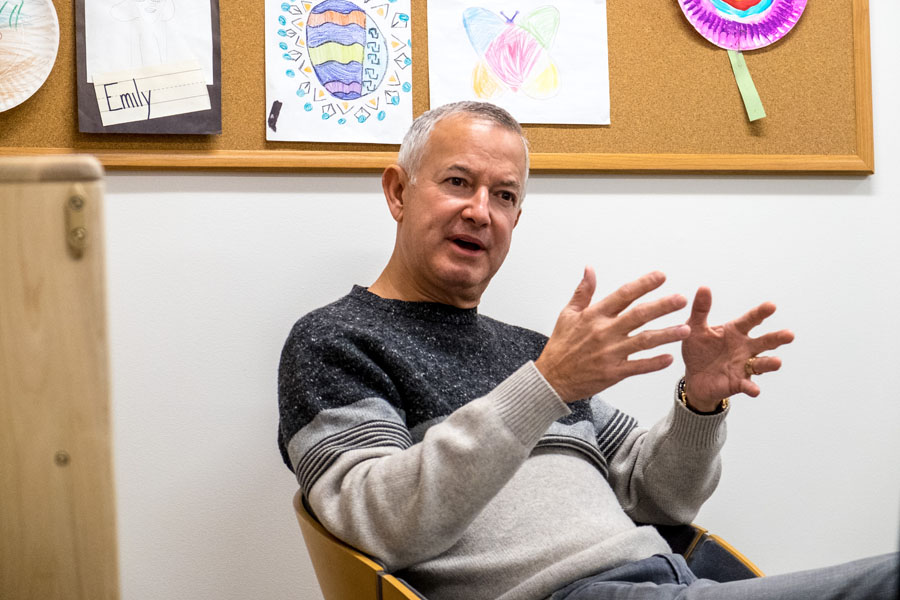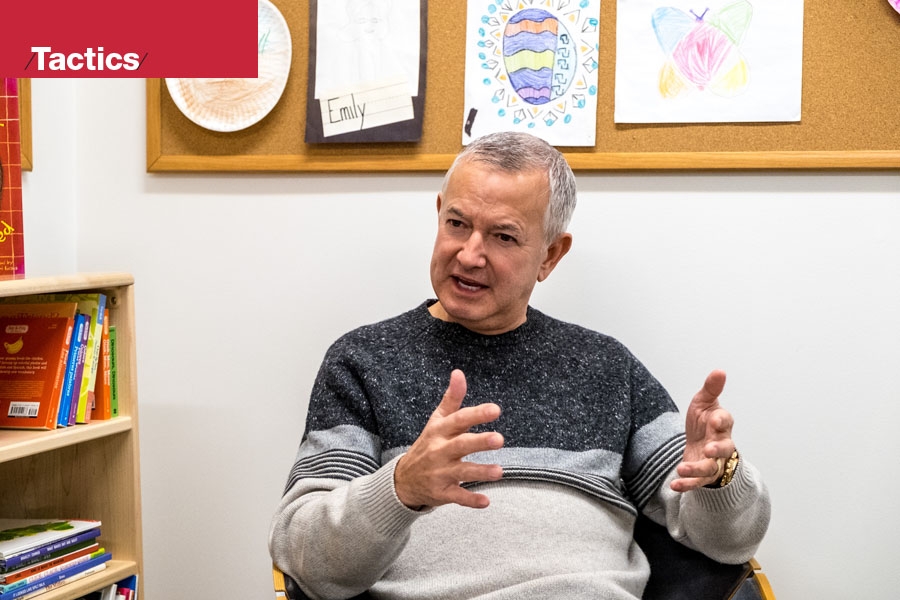The CEO of KinderCare discusses the impact of consolidation, the tight labor market and why more employers are choosing onsite day cares.
Tom Wyatt heads Portland-headquartered KinderCare Education, the largest child care provider in the U.S. In August the company fortified its leading market presence by acquiring Michigan-based Rainbow Child Care Center, the U.S.’s eighth-largest child care provider. The acquisition expanded KinderCare’s presence to more than 1,400 centers in 40 states.
In an interview with Oregon Business, Wyatt talked about his growth plans, why more companies want to provide on-site day cares for their employees and what the trend toward universal pre-K means for his business.
Excerpts have been edited for length and clarity. Photos by Jason Kaplan.
You were already the largest child care provider before you acquired Rainbow Child Care Center. Why get bigger?
It is a very fragmented business. If you take the top three players: We are No. 1; Learning Care Group is No. 2; Bright Horizons is No. 3. Those three don’t equal 10% of the marketplace. There are a lot of mom-and-pops, a lot of faith-based, smaller providers. It is a $53 billion industry. One of our strategies is to grow organically. Another strategy is to grow by building out new centers, which we are doing this year, as well as acquiring other centers. The strategy around Rainbow was to buy something significantly larger than just one or two centers.
What is the biggest challenge you face as you get larger?
Consistency. One of the reasons we spend so much time thinking about quality and culture is they mean so much to the parents and the children we serve. When you have as many centers as we do, the opportunity to ensure there is high quality in every one of them is a challenge. One of the ways we meet that challenge is we are the most accredited organization in the field. Accreditation is far above licensing. Licensing is really just an entry to offering child care.

How do you maintain your corporate culture as you expand?
Especially with the Rainbow acquisition, it is a huge challenge. We partner with Gallup. We ask employees 12 questions every year on how we are doing. The questions don’t change. It helps us to see whether we are improving or not.
Culture in any company I have run has been a mainstay for me. I believe happy and engaged employees are more productive and apt to stay. But then you think about what we do; we are taking care of the most precious asset you have – your child. This is why the engagement of teachers is so important in the classroom, the engagement between the center director and parent. It is an emotional business. We want to create an environment that is emotionally connected to everyone we serve.
Child care workers often earn minimum wage. It is a tight labor market, and employers have to compete more to retain workers. How are you affected by these market conditions?
We are not at minimum wage. We are above it, but not far above it. Teachers are remarkable, mission-driven people. They are certainly not doing it for the financial rewards. They teach for the emotional rewards of serving families with children. We do a couple of things that are unique to the industry. We get over 1,000 inquiries a week from people who want to be in the industry. We worked for more than two years building a selection tool whereby we ask every applicant a number of questions. The filtering tool helps us a lot.
We interview 400 of our best teachers and ask why they are staying at KinderCare. We have a wide breadth of pay scales based on geographies, urban markets, suburban markets. We also have a keen eye on who we are competing against for teachers. Those are public schools, as well as other early-childhood education providers.
What is the biggest mistake child care providers make?
A lot of people are very transactional in this industry. A lot of people use off-the-shelf curriculum, which is staid and static. Less than 5% of the entire industry is accredited. We are almost 100% accredited. The fact that people are not taking quality as seriously as they should is a mistake. Not realizing how important the journey the child is going on and selling that short at any place in the development of that child, socially or academically, is wrong.
Gov. Kate Brown has ordered tighter oversight of day care centers after abuse of a child was discovered at a licensed day care in Southeast Portland. How serious are the gaps in regulatory practices in the state?
I do believe she is right in tightening it up. Licensing to me is only an entry into the business. We really believe a high-quality center is a center that is validated by outside people. We partner with the National Association for the Education of Young Children to have all our centers validated. We have spoken to Gov. Brown’s team in that regard, and we have talked to them about what we think are the options – whether it is student-to-teacher ratios, the preparation of a teacher and the credentials of a teacher. I think Gov. Brown is doing good work. She is addressing some things that have been a little less formalized in Oregon than they should have been.

Why is there more demand from employers to have on-site child care?
Quite frankly, the workforce is demanding it. The millennial looks at their benefits package far differently from how a midlife baby boomer did. A 401(k) or a pension plan was part of the lure to get you to join a certain company. Today child care and work-life balance are far reaching and very different from what was expected of an employer even 10 years ago.
The activity we have in our business development group that goes out to work with clients to see whether or not they should add a center is exploding right now. It is one of the best, active parts of our business. We have three companies right now that want to open six to eight on-site child care centers in different states; they don’t have a single one at this point. It is because they are looking at their workforce and realizing talent is at a premium. We have the lowest unemployment we have had in a very long time. Because of that, you have a lot of options as an employee.
What will be the biggest disruption to the child care business in the next 10 years?
Continued consolidation of the industry, which I consider to be healthy. The more people who have scale like we do, the better the curriculum, better teacher benefits and slow teacher turnover.
The other is universal pre-K. States, cities and municipalities are offering that option for free. It is not usually all day and every day. Parents who work still have to find alternatives for their child. Georgia has a pre-K program. Florida has a robust pre-K program. We actually participate in those two and offer our facilities, because they can offer to provide universal pre-K, but they do not have facilities or real estate to provide it in. Manhattan offers universal pre-K. We provide facilities for that. That is a disruptive factor. To give you an example: We have 4,000 more infants in our schools than we ever did in the history of the company. Our demographic is getting younger because there are other options for children aged 3 and 4. That has been a bit disruptive but also an opportunity.
To subscribe to Oregon Business click here.





